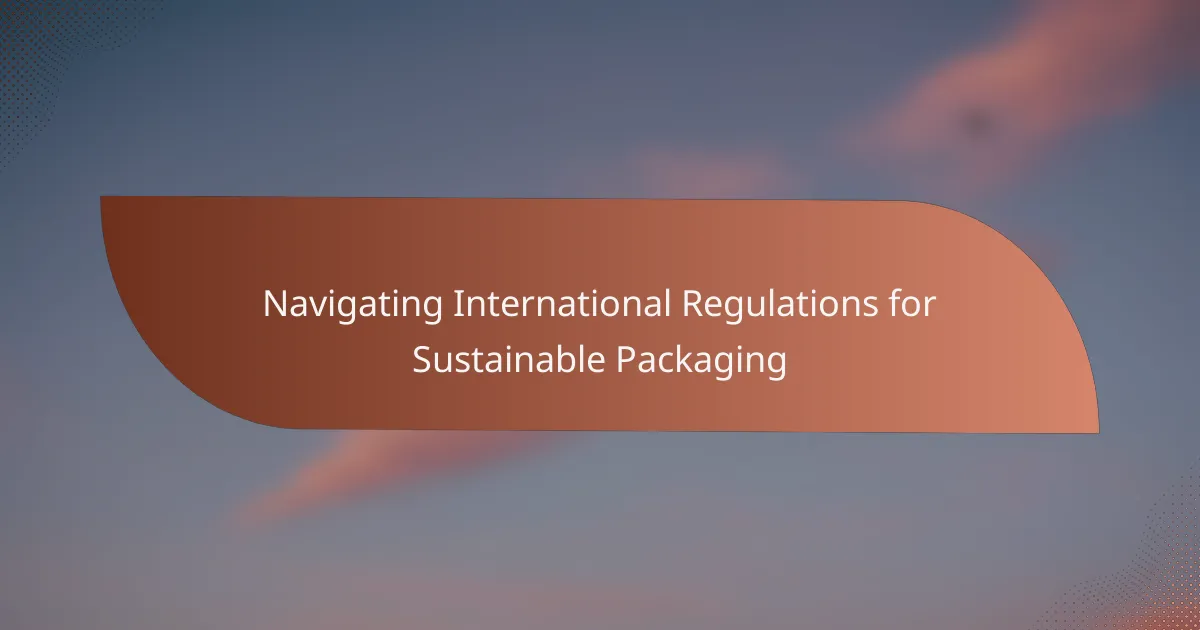Navigating international regulations for sustainable packaging is crucial for businesses seeking to minimize their environmental impact while complying with legal standards. These regulations emphasize waste reduction, recyclability, and the use of eco-friendly materials, which can significantly enhance brand reputation and customer loyalty. By understanding and implementing these guidelines, companies can not only meet consumer expectations but also contribute to a more sustainable future.
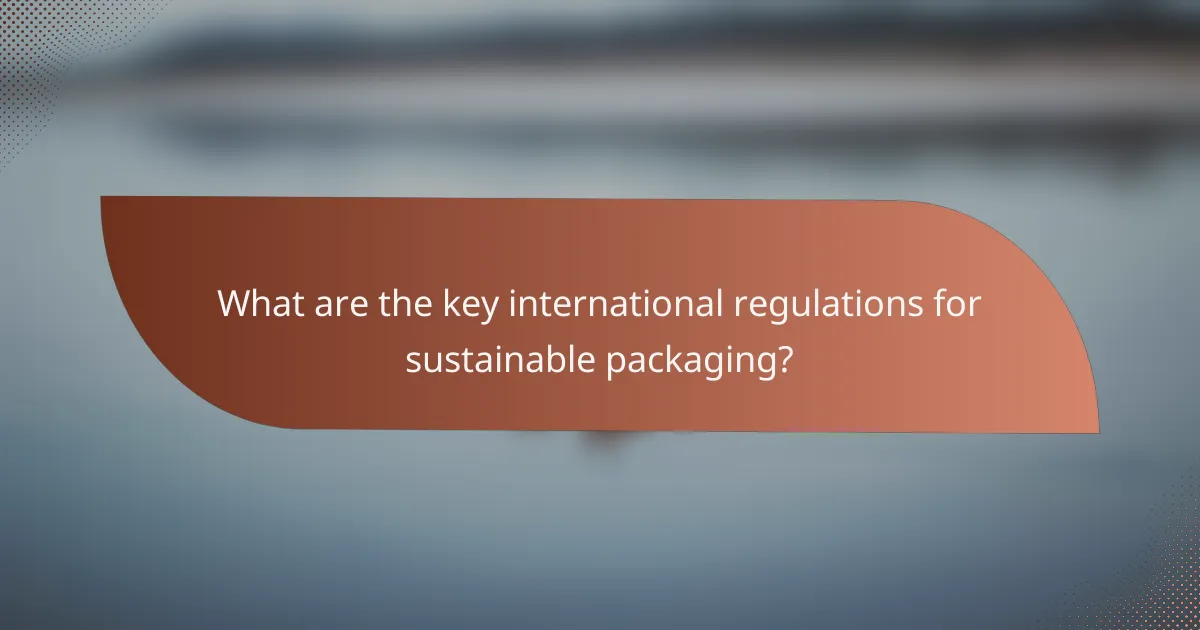
What are the key international regulations for sustainable packaging?
Key international regulations for sustainable packaging focus on reducing waste, promoting recyclability, and minimizing environmental impact. Understanding these regulations is essential for businesses aiming to comply with legal standards and meet consumer expectations.
European Union Packaging and Packaging Waste Directive
The European Union’s Packaging and Packaging Waste Directive aims to prevent packaging waste and promote recycling and reuse. It sets essential requirements for packaging design, ensuring that materials are recoverable and recyclable.
Businesses must ensure that their packaging meets specific recycling targets, which can vary by material type. For example, by 2025, at least 65% of all packaging waste must be recycled, with higher targets for plastic packaging.
US Federal Trade Commission Green Guides
The US Federal Trade Commission’s Green Guides provide guidance on environmental marketing claims, helping businesses avoid misleading consumers. These guidelines emphasize that claims about sustainability must be substantiated and not vague.
For instance, if a product is labeled as “biodegradable,” it must decompose within a specific timeframe in a natural environment. Companies should be cautious about using terms like “eco-friendly” without clear definitions and evidence.
Canada’s Plastic Waste Reduction Strategy
Canada’s Plastic Waste Reduction Strategy focuses on reducing plastic pollution and promoting sustainable packaging solutions. The strategy includes measures to phase out harmful single-use plastics and encourages businesses to adopt more sustainable materials.
Companies should be aware of the upcoming regulations that will require them to report on their plastic use and waste management practices. Transitioning to recyclable or compostable materials is a key step in compliance.
Australia’s National Plastics Plan
Australia’s National Plastics Plan aims to reduce plastic waste and improve recycling rates across the country. The plan includes commitments to phase out certain single-use plastics and promote the use of recycled content in packaging.
Businesses are encouraged to adopt sustainable practices, such as using materials that are recyclable or made from recycled content. Engaging with local recycling programs can also enhance compliance with national goals.
Japan’s Container and Packaging Recycling Law
Japan’s Container and Packaging Recycling Law mandates that manufacturers and importers take responsibility for the recycling of their packaging. This law promotes a circular economy by requiring businesses to contribute to recycling programs.
Companies must pay recycling fees based on the type and amount of packaging they produce. Understanding these obligations is crucial for compliance and can help businesses reduce their environmental footprint.
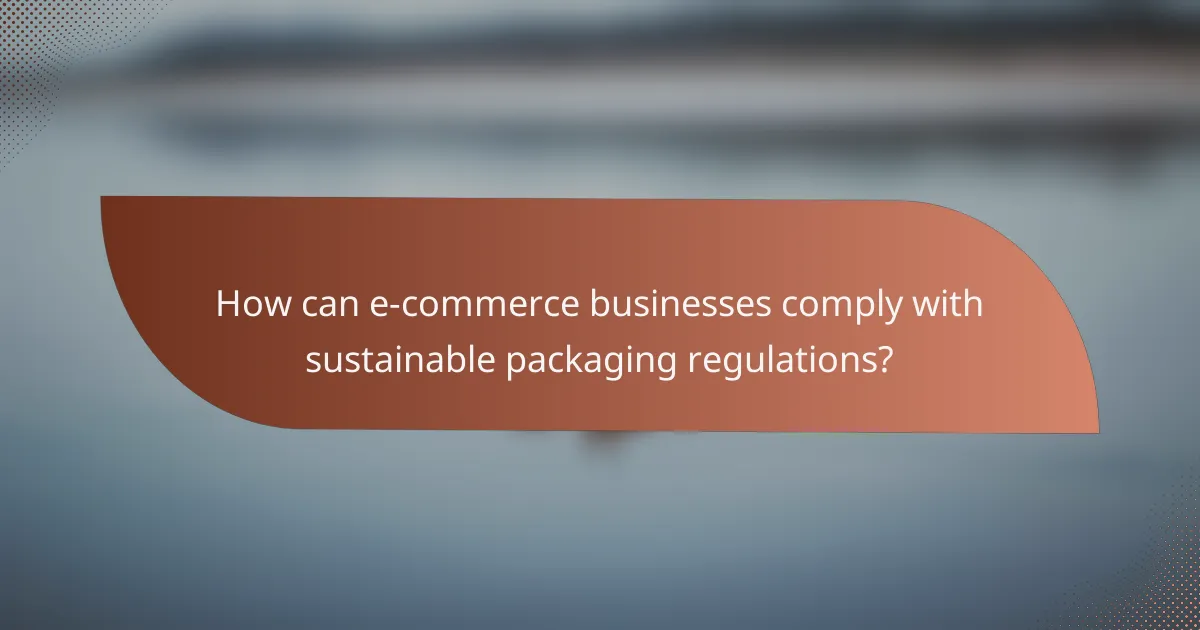
How can e-commerce businesses comply with sustainable packaging regulations?
E-commerce businesses can comply with sustainable packaging regulations by integrating eco-friendly materials, adopting circular economy principles, and conducting regular compliance audits. These steps not only meet legal requirements but also enhance brand reputation and customer loyalty.
Implementing eco-friendly materials
Using eco-friendly materials is crucial for compliance with sustainable packaging regulations. Businesses should consider biodegradable, recyclable, or compostable options that minimize environmental impact. For example, replacing plastic with materials like recycled paper or plant-based plastics can significantly reduce waste.
It’s essential to verify that the chosen materials meet local regulations regarding sustainability. In the EU, for instance, packaging must comply with the Packaging and Packaging Waste Directive, which encourages the use of materials that can be reused or recycled.
Adopting circular economy principles
Adopting circular economy principles involves designing packaging that can be reused, repaired, or recycled. This approach not only reduces waste but also conserves resources. E-commerce businesses can implement take-back programs, allowing customers to return packaging for reuse or recycling.
Consider collaborating with suppliers who prioritize circular practices. This could include sourcing materials from companies that use recycled content or those that offer packaging solutions designed for multiple uses. Such partnerships can enhance sustainability efforts and compliance.
Conducting regular compliance audits
Regular compliance audits are essential for ensuring adherence to sustainable packaging regulations. These audits should assess materials, processes, and supplier practices to identify areas for improvement. Setting a schedule for audits, such as quarterly or bi-annually, can help maintain accountability.
During audits, businesses should review documentation related to material sourcing and recycling processes. This not only helps in meeting regulatory standards but also prepares the company for potential inspections by regulatory bodies. Keeping accurate records can streamline this process and demonstrate commitment to sustainability.
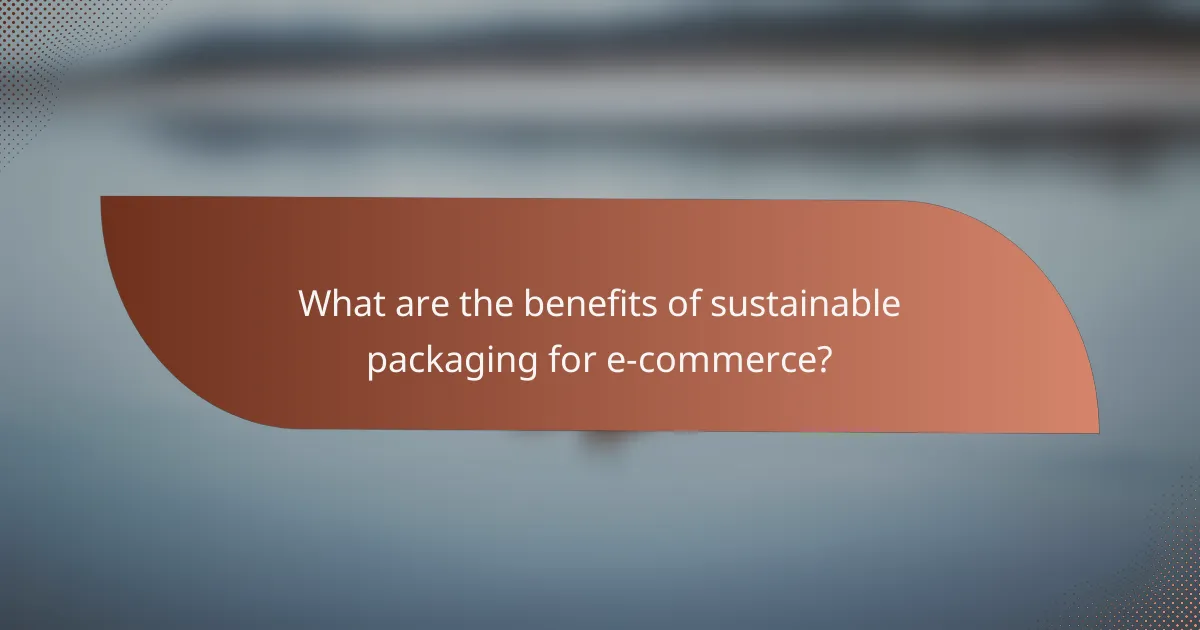
What are the benefits of sustainable packaging for e-commerce?
Sustainable packaging offers numerous advantages for e-commerce businesses, including improved brand image, cost efficiency, and enhanced customer loyalty. By adopting eco-friendly materials and practices, companies can meet consumer demand for sustainability while potentially reducing operational costs.
Enhanced brand reputation
Implementing sustainable packaging can significantly boost a brand’s reputation. Consumers increasingly prefer brands that demonstrate environmental responsibility, which can lead to positive word-of-mouth and increased market share.
For example, companies that use biodegradable materials or recyclable packaging often attract environmentally conscious customers. This alignment with consumer values can differentiate a brand in a crowded marketplace.
Cost savings through waste reduction
Switching to sustainable packaging can lead to substantial cost savings by minimizing waste. Efficient packaging design reduces material usage and shipping costs, as lighter packages often incur lower transportation fees.
Consider using materials that are both sustainable and cost-effective, such as recycled cardboard or compostable plastics. Over time, these choices can lead to lower disposal costs and improved operational efficiency.
Increased customer loyalty
Customers are more likely to remain loyal to brands that prioritize sustainability. By offering eco-friendly packaging, e-commerce businesses can foster a sense of community and shared values with their customers.
Engaging customers through initiatives like recycling programs or incentives for returning packaging can further enhance loyalty. Brands that communicate their sustainability efforts effectively can build long-term relationships with their clientele.
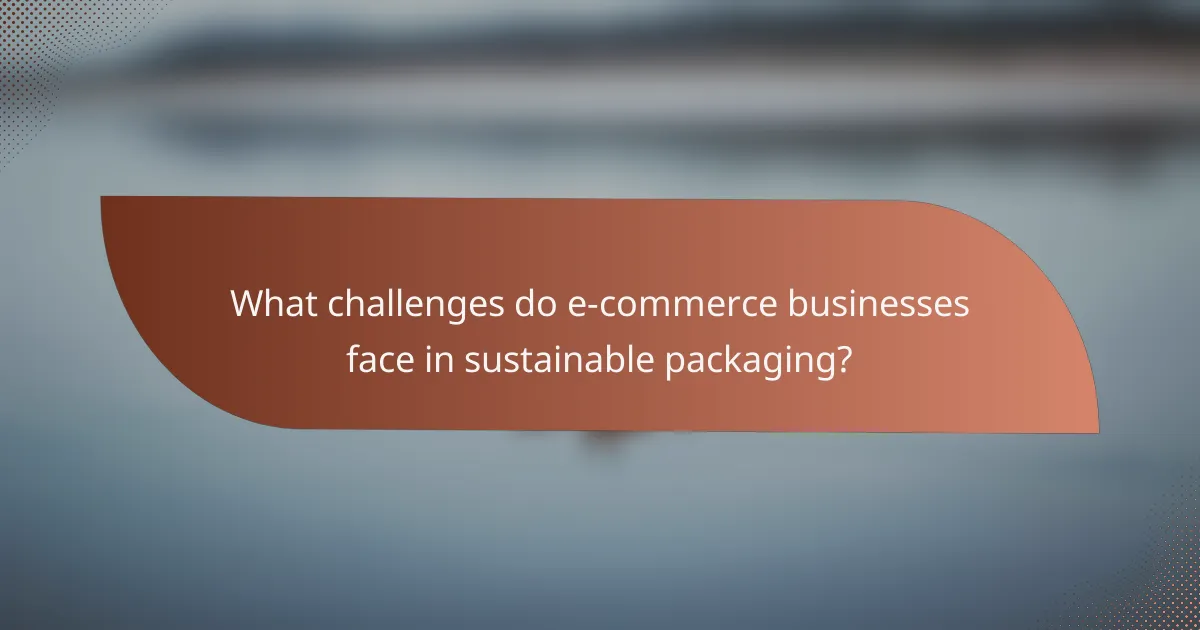
What challenges do e-commerce businesses face in sustainable packaging?
E-commerce businesses encounter several challenges in implementing sustainable packaging, including high initial costs, complex supply chains, and the need for consumer education. Addressing these issues is crucial for achieving both environmental goals and customer satisfaction.
High initial investment costs
Transitioning to sustainable packaging often requires significant upfront investment. Businesses may need to source eco-friendly materials, redesign packaging, or invest in new machinery, which can lead to costs in the low thousands to tens of thousands of dollars.
While these initial expenses can be daunting, they may lead to long-term savings through reduced waste disposal fees and improved brand loyalty. Companies should evaluate the potential return on investment by considering factors like customer demand for sustainable options.
Supply chain complexities
Implementing sustainable packaging can complicate supply chains due to the need for new suppliers and materials. E-commerce businesses must ensure that their suppliers adhere to sustainability standards, which may require additional vetting and coordination.
Moreover, sourcing sustainable materials may involve longer lead times and increased logistics challenges. Companies should develop strong relationships with reliable suppliers and consider local sourcing to mitigate these complexities and reduce carbon footprints.
Consumer awareness and education
Many consumers remain unaware of the benefits of sustainable packaging, which can hinder its adoption. E-commerce businesses must actively educate their customers about the environmental impact of packaging choices and the advantages of sustainable options.
Effective strategies include clear labeling, informative content on websites, and engaging social media campaigns. By fostering consumer awareness, businesses can drive demand for sustainable packaging solutions and enhance their brand’s reputation.
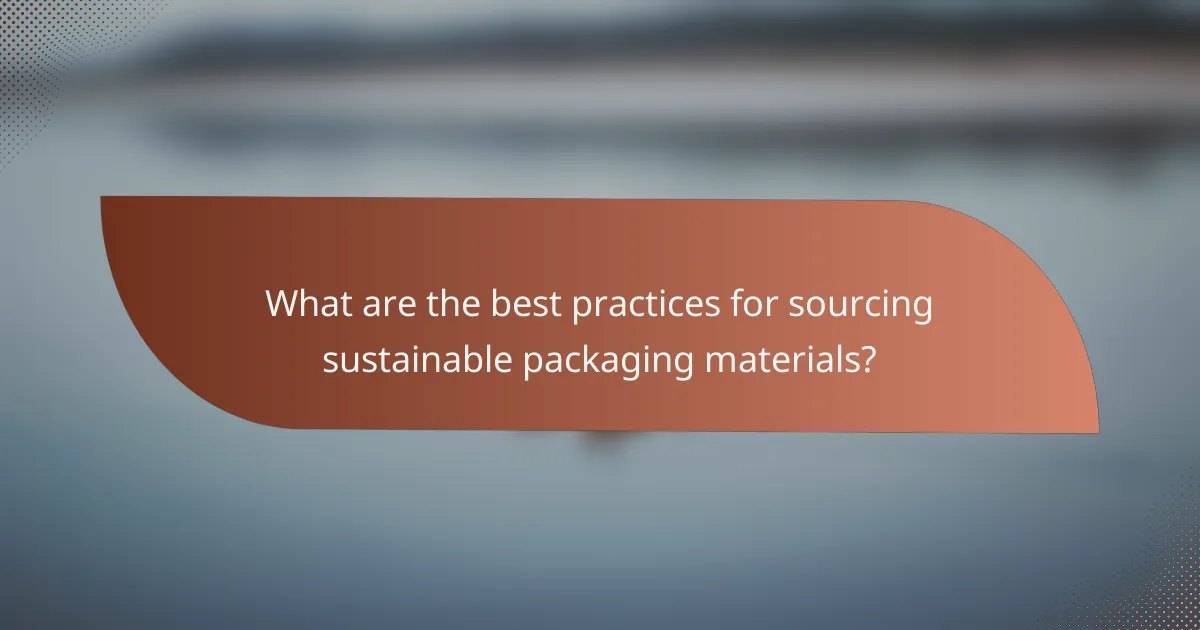
What are the best practices for sourcing sustainable packaging materials?
Best practices for sourcing sustainable packaging materials involve selecting eco-friendly options, ensuring compliance with regulations, and prioritizing suppliers who demonstrate a commitment to sustainability. This approach not only reduces environmental impact but also enhances brand reputation.
Choosing certified suppliers
Choosing certified suppliers is crucial for ensuring that the packaging materials meet sustainability standards. Look for certifications such as FSC (Forest Stewardship Council) or Cradle to Cradle, which indicate responsible sourcing and production practices.
When evaluating suppliers, consider their transparency regarding material sourcing and production processes. Request documentation of certifications and ask about their sustainability practices to ensure they align with your company’s values.
Additionally, establish long-term relationships with suppliers who prioritize sustainability. This can lead to better pricing, consistent quality, and collaborative efforts to innovate in sustainable packaging solutions.
